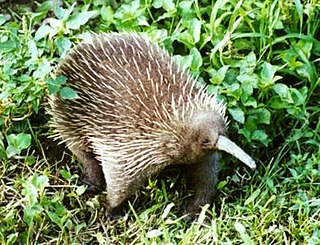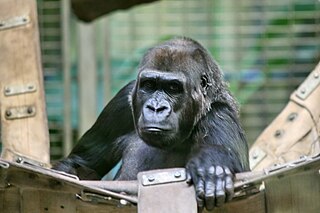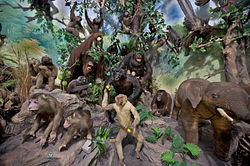
Hunting is the human practice of seeking, pursuing, capturing, or killing wildlife or feral animals. The most common reasons for humans to hunt are to exploit the animal's body for food and useful animal products, for recreation/taxidermy, although it may also be done for non-exploitative reasons such as removing predators dangerous to humans or domestic animals, to eliminate pests and nuisance animals that damage crops/livestock/poultry or spread diseases, for trade/tourism, or for ecological conservation against overpopulation and invasive species.
The conservation movement, also known as nature conservation, is a political, environmental, and social movement that seeks to manage and protect natural resources, including animal, fungus, and plant species as well as their habitat for the future. Conservationists are concerned with leaving the environment in a better state than the condition they found it in. Evidence-based conservation seeks to use high quality scientific evidence to make conservation efforts more effective.

A nature reserve is a protected area of importance for flora, fauna, or features of geological or other special interest, which is reserved and managed for purposes of conservation and to provide special opportunities for study or research. They may be designated by government institutions in some countries, or by private landowners, such as charities and research institutions. Nature reserves fall into different IUCN categories depending on the level of protection afforded by local laws. Normally it is more strictly protected than a nature park. Various jurisdictions may use other terminology, such as ecological protection area or private protected area in legislation and in official titles of the reserves.

Wildlife refers to undomesticated animal species, but has come to include all organisms that grow or live wild in an area without being introduced by humans. Wildlife was also synonymous to game: those birds and mammals that were hunted for sport. Wildlife can be found in all ecosystems. Deserts, plains, grasslands, woodlands, forests, and other areas, including the most developed urban areas, all have distinct forms of wildlife. While the term in popular culture usually refers to animals that are untouched by human factors, most scientists agree that much wildlife is affected by human activities. Some wildlife threaten human safety, health, property, and quality of life. However, many wild animals, even the dangerous ones, have value to human beings. This value might be economic, educational, or emotional in nature.

Habitat conservation is a management practice that seeks to conserve, protect and restore habitats and prevent species extinction, fragmentation or reduction in range. It is a priority of many groups that cannot be easily characterized in terms of any one ideology.

Medan is the capital and largest city of the Indonesian province of North Sumatra, as well as a regional hub and financial centre of Sumatra. According to the National Development Planning Agency, Medan is one of the four main central cities of Indonesia, alongside Jakarta, Surabaya, and Makassar. As of the 2020 Census, Medan has a population of 2,435,252 within its city limits, and over 3.4 million in its built-up urban area, making it the fourth largest urban area in Indonesia. The Medan metropolitan area—which includes neighbouring Binjai, Deli Serdang Regency, and a part of Karo Regency—is the largest metropolitan area outside of Java, with 4,744,323 residents counted in the 2020 Census. Medan is a multicultural metropolis and a busy trading city bordered by the Strait of Malacca, making it one of the major economic cities in Indonesia. A gateway to the western part of Indonesia, Medan is supported by the Port of Belawan and Kualanamu International Airport. Both which are connected to the city centre via toll roads and railways.

The Federal Duck Stamp, formally known as the Migratory Bird Hunting and Conservation Stamp, is an adhesive stamp issued by the United States federal government that must be purchased prior to hunting for migratory waterfowl such as ducks and geese. It is also used to gain entrance to National Wildlife Refuges that normally charge for admission. It is widely seen as a collectable and a means to raise funds for wetland conservation, with 98% of the proceeds of each sale going to the Migratory Bird Conservation Fund.

A game reserve is a large area of land where wild animals live safely or are hunted in a controlled way for sport. If hunting is prohibited, a game reserve may be considered a nature reserve; however, the focus of a game reserve is specifically the animals (fauna), whereas a nature reserve is also, if not equally, concerned with all aspects of native biota of the area.

The International Council for Game and Wildlife Conservation (CIC) (French: Conseil International de la Chasse et de la Conservation du Gibier, German: Internationaler Rat zur Erhaltung des Wildes und der Jagd) is a politically independent not-for-profit international organisation, aiming to preserve wildlife through the promotion of sustainable use of wildlife resources. The initialism "CIC" comes from the organisation's original French name Conseil International de la Chasse.
The Canadian Wildlife Service or CWS, is a Branch of the Department of the Environment, a department of the Government of Canada. November 1, 2012 marked the 65th anniversary of the founding of Service.

The conservation status of a group of organisms indicates whether the group still exists and how likely the group is to become extinct in the near future. Many factors are taken into account when assessing conservation status: not simply the number of individuals remaining, but the overall increase or decrease in the population over time, breeding success rates, and known threats. Various systems of conservation status exist and are in use at international, multi-country, national and local levels as well as for consumer use.

Wildlife management is the management process influencing interactions among and between wildlife, its habitats and people to achieve predefined impacts. It attempts to balance the needs of wildlife with the needs of people using the best available science. Wildlife management can include wildlife conservation, gamekeeping and pest control. Wildlife management draws on disciplines such as mathematics, chemistry, biology, ecology, climatology and geography to gain the best results.

The western long-beaked echidna is one of the four extant echidnas and one of three species of Zaglossus that occurs in New Guinea. Originally described as Tachyglossus bruijnii, this is the type species of Zaglossus.

Wildlife tourism is an element of many nations' travel industry centered around observation and interaction with local animal and plant life in their natural habitats. While it can include eco- and animal-friendly tourism, safari hunting and similar high-intervention activities also fall under the umbrella of wildlife tourism. Wildlife tourism, in its simplest sense, is interacting with wild animals in their natural habitat, either by actively or passively. Wildlife tourism is an important part of the tourism industries in many countries including many African and South American countries, Australia, India, Canada, Indonesia, Bangladesh, Malaysia, Sri Lanka and Maldives among many. It has experienced a dramatic and rapid growth in recent years worldwide and many elements are closely aligned to eco-tourism and sustainable tourism.

The Malayan civet, also known as the Malay civet and Oriental civet, is a viverrid native to the Malay Peninsula and the islands of Sumatra, Bangka, Borneo, the Riau Archipelago, and the Philippines. It is listed as "Least Concern" by IUCN as it is a relatively widely distributed, appears to be tolerant of degraded habitats, and occurs in a number of protected areas.

The wildlife of Jordan includes its flora and fauna and their natural habitats. Although much of the country is desert, it has several geographic regions, each with a diversity of plants and animals adapted to their own particular habitats. Fossil finds show that in Palaeolithic times, the region had Syrian brown bears, Asiatic lions, zebras, Asian elephants, and rhinoceroses, but these species are all now extinct in this region.

An endangered species is a species that is very likely to become extinct in the near future, either worldwide or in a particular political jurisdiction. Endangered species may be at risk due to factors such as habitat loss, poaching and invasive species. The International Union for Conservation of Nature (IUCN) Red List lists the global conservation status of many species, and various other agencies assess the status of species within particular areas. Many nations have laws that protect conservation-reliant species which, for example, forbid hunting, restrict land development, or create protected areas. Some endangered species are the target of extensive conservation efforts such as captive breeding and habitat restoration.

Conservation photography is the active use of the photographic process and its products, within the parameters of photojournalism, to advocate for conservation outcomes.

Wildlife in the Central African Republic is in the vast natural habitat located between the Congo Basin's rain forests and large savannas, where the human density was smaller than 0.5 per km2 prior to 1850. The forest area of 22.755 million, considered one of the richest storehouses of wildlife spread over national parks, hunting reserves and community hunting areas, experienced an alarming loss of wildlife because of greed for ivory and bushmeat exploitation by hunters – mostly Arab slavers from across the borders of the Central African Republic with Chad and Sudan.
Thomas D. Mangelsen is an American nature and wildlife photographer and conservationist. He is most famous for his photography of wildlife in the Greater Yellowstone Ecosystem, as he has lived inside the zone in Jackson, Wyoming, for over 40 years. In 2015, he and nature author Todd Wilkinson created a book, The Grizzlies of Pilgrim Creek, featuring a grizzly bear known as Grizzly 399, named so due to her research number. He has been active in the movement to keep the Yellowstone area grizzly bears on the Endangered Species List. Mangelsen is also known for trekking to all seven continents to photograph a diverse assortment of nature and wildlife. A photograph he took in 1988 titled, "Catch of the Day" has been labeled "the most famous wildlife photograph in the world". In May 2018, he was profiled on CBS 60 Minutes. He has received dozens of accolades throughout the decades.

















